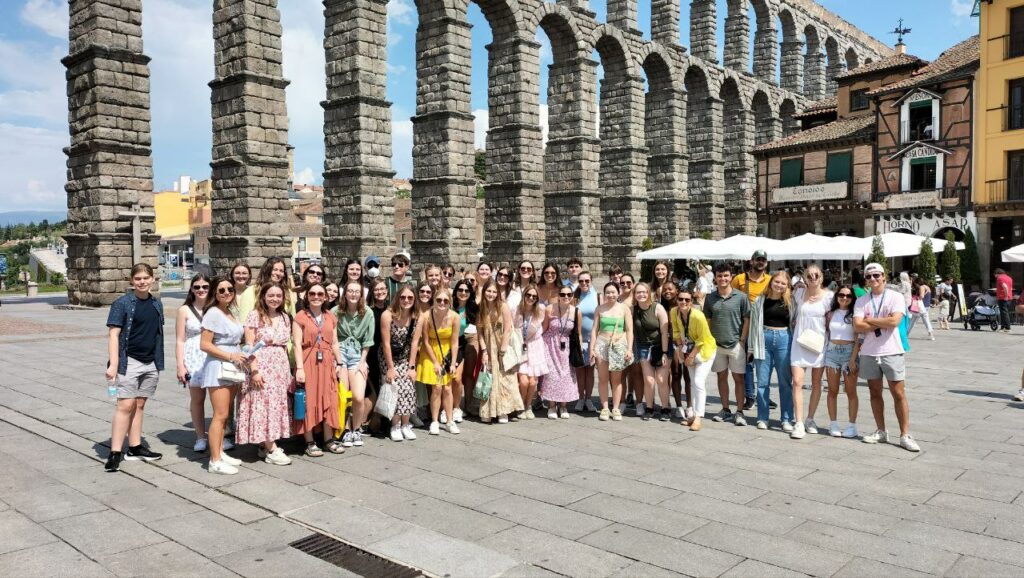¿Qué tal, amigos? It’s Ryan here, back with an update from Madrid, Spain. As I get more settled in here, the days seem to fly by faster and faster! It’s been another fun-filled week, and I’m glad I get to tell you more about it. Sit back, relax, and enjoy this quick update.
El Barrio de las Letras
This week has been all about the arts—literature and visual art alike. Over the centuries, Spain has given the world countless brilliant works that fall under these two categories, and I had several opportunities this week to learn about those works and the people who produced them. Early on in the week, I visited el Barrio de las Letras (in English, this translates roughly to the Neighborhood of Letters). It is very aptly named, as it was home to many a famous author back in the day. While there, we visited the houses of authors Francisco de Quevedo and Miguel de Cervantes. I found it especially interesting to see the house where Miguel de Cervantes lived—he actually died there, too, penniless. He would unfortunately not survive to enjoy the immense success of his novel, Don Quijote.
El Prado
One of my favorite experiences of my study abroad program so far has been visiting el Prado, one of the largest classical art museums in Europe. I first visited the museum on Thursday of this week; I loved it so much that I returned on Friday, and I plan on going back at least one more time before I head back to the states. Here are a few fun facts that I learned during my visits:
- My favorite painting from el Prado—Las Meninas by Diego Velázquez—was actually pretty revolutionary for its time. Velázquez was what you would call a chamber painter; he painted portraits for the royal family. The portraits were always very staged: one person, a neatly set-up background, and a professional pose. Las Meninas, however, captures a moment in time, with motion and depth and multiple members of the Spanish royal family and their court. Velázquez himself can even be seen on the left side of the painting. I would encourage you to look up the painting and take a look. It’s pretty neat if I do say so myself!
- Another famous chamber painter from several centuries ago was Francisco Goya. I actually learned a couple fun facts about him. First of all, he was deaf. Second of all, he painted portraits of nobles and members of the royal family, just like Velázquez. But, here’s the fun part: if he liked the person he was painting, he would paint them in a good light. If he disliked them–well, he enhanced their disagreeable features, essentially turning the paintings into subtle caricatures. I saw a few examples of this in el Prado.
- El Prado is home to some hidden gems—literally. On the highest floor of the museum, there is a somewhat hidden gallery that displays the Dauphin’s Treasure, a collection of dishes and ornaments made of precious stones, metals, and crystal that used to belong to the Spanish royal family. It’s worth a look if you’re ever in Madrid!
Segovia
To top off the week, we visited Segovia, a city in Castilla y León that was extremely important throughout the history of Spain. The presence of the ancient Roman Empire is obvious at the entrance of the city, where a 2-thousand-year-old aqueduct stands. (Another fun fact–did you know that the stones of the aqueduct aren’t held together with any sort of plaster or anything? The pressure between the stones is what keeps it standing.) Segovia is also home to el Alcázar, the palace where Isabel of Castilla and Fernando de Aragón lived during the late 15th and early 16th centuries. We visited the palace and even climbed to the top of its highest tower. Another highlight of the visit was trying ponche—a custard-filled dessert famous in Segovia.

Well, that’s about all I’ve got for now! I hope you enjoyed reading a little bit about my experiences here in Spain. I’m already halfway through my trip, which is hard to believe! I’ll be back next week with another update.
Hasta luego,
Ryan
